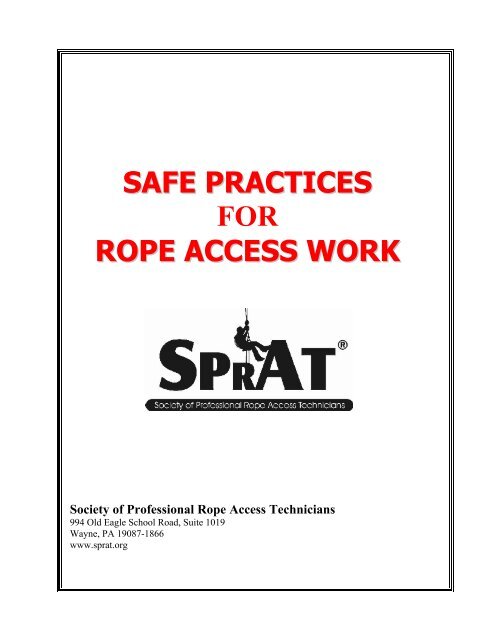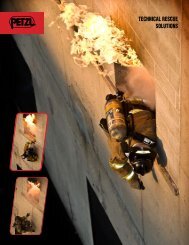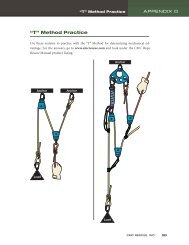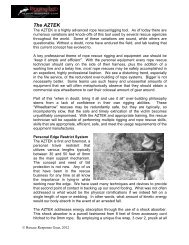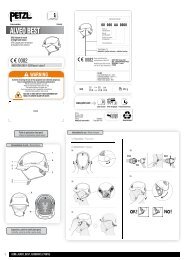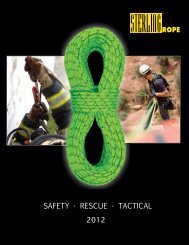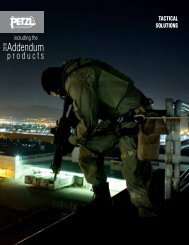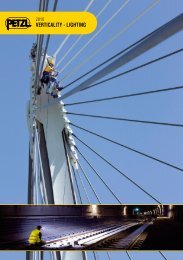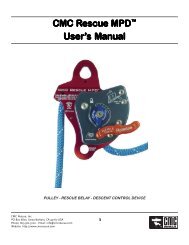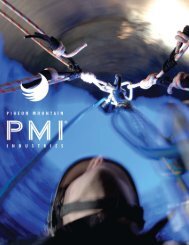safe practices for rope access work - Rescue Response Gear
safe practices for rope access work - Rescue Response Gear
safe practices for rope access work - Rescue Response Gear
- No tags were found...
Create successful ePaper yourself
Turn your PDF publications into a flip-book with our unique Google optimized e-Paper software.
SAFE PRACTICESFORROPE ACCESS WORKSociety of Professional Rope Access Technicians994 Old Eagle School Road, Suite 1019Wayne, PA 19087-1866www.sprat.org
© 2007 Society of Professional Rope Access Technicians Page 2January 15, 2007 edition
SAFE PRACTICES FORROPE ACCESS WORKINDEX1. Scope and Purpose2. Definitions3. General Requirements4. Employee Selection and Capabilities5. Duties and Responsibilities of Employers6. Duties and Responsibilities of the RopeAccess Program Manager7. Duties and Responsibilities of the RopeAccess Supervisor8. Duties and Responsibilities of the RopeAccess Lead Technician9. Duties and Responsibilities of the RopeAccess Worker10. Rope Access Equipment11. Communications Systems12. Use of Suspended Work Plat<strong>for</strong>ms inConjunction with Rope Access13. Tools and Work Equipment14. <strong>Rescue</strong> and Emergency Services15. Appendix1 SCOPE AND PURPOSE1.1 ScopeThis document sets <strong>for</strong>th accepted <strong>practices</strong><strong>for</strong> <strong>rope</strong> <strong>access</strong> <strong>work</strong>. This document doesnot apply to emergency response oremergency response training, except asprovided in Section 14.1.2 PurposeThe purpose of this document is to providein<strong>for</strong>mation and guidance on acceptable<strong>practices</strong> and procedures to protectemployees from the hazards associated with<strong>rope</strong> <strong>access</strong> <strong>work</strong> methods when <strong>work</strong>ing atheight. This document is written <strong>for</strong> allpersons concerned with <strong>rope</strong> <strong>access</strong> <strong>work</strong>,but especially <strong>for</strong> those primarily responsible<strong>for</strong> establishing and administering <strong>rope</strong><strong>access</strong> <strong>work</strong> methods. This documentcontains requirements recommended <strong>for</strong>use by en<strong>for</strong>cement authorities inestablishing regulations or codes on <strong>rope</strong><strong>access</strong> <strong>work</strong> methods.1.3 “Shall” and “Should”The provisions are mandatory in naturewhere the word “Shall” is used and advisoryin nature where the word “should” is used.1.4 ExceptionsRegulatory agencies may haverequirements that are different from thisstandard.© 2007 Society of Professional Rope Access Technicians Page 3January 15, 2007 edition
2 DEFINITIONSAccess Permit: A written statementprepared by the employer describing how aparticular job (or types of jobs where thesewill be essentially identical) should beundertaken to ensure any risks to health and<strong>safe</strong>ty of the <strong>work</strong>ers, or others who may beaffected, are minimized.Access Zone: The area in which people areat risk of falling such as on-line or near a<strong>work</strong>ing edge. This area requires protectivemeasures such as verbal warnings, signs,barriers, <strong>safe</strong>ty lines, or other devicesdesigned to prevent or arrest a fall.Anchor, Anchorage: A place, fixing orfixture that supports and to which thevarious <strong>rope</strong>s and <strong>rope</strong> systems areattached.Approved Equipment: Equipment deemedappropriate <strong>for</strong> use with <strong>rope</strong> <strong>access</strong>techniques. Approved equipment shall meetthe specifications set <strong>for</strong>th herein, or otherspecifications set <strong>for</strong>th in the <strong>access</strong> permit,if more stringent.Ascender: A type of <strong>rope</strong> grab that is usedprimarily <strong>for</strong> climbing <strong>rope</strong> by griping the<strong>rope</strong> when loaded in one direction andsliding freely in the opposite direction. Notethat many ascender type <strong>rope</strong> grabs are notsufficient <strong>for</strong> fall arrest.Attendant: An individual stationed at thesite of the <strong>rope</strong> <strong>access</strong> <strong>work</strong> who monitorsthe <strong>rope</strong> <strong>access</strong> <strong>work</strong>ers and who per<strong>for</strong>msall Rope Access Attendant duties assignedin the employer’s <strong>rope</strong> <strong>access</strong> <strong>work</strong>program.Belay: An active system operated byanother employee <strong>for</strong> the purpose ofarresting the fall of a <strong>rope</strong> <strong>access</strong> <strong>work</strong>er.Carabiner: A type of connector, <strong>for</strong>med as acomplete loop with a spring-loaded entrygate.Carabiner, Locking*: A carabiner with amechanism that reduces the possibility of agate being opened inadvertently. A lockingmechanism requires at least two differentconsecutive manual actions to open thegate.Descender: A device that acts as a frictionbrake on a <strong>rope</strong>. It is normally attached tothe operator and enables the operator tocontrol the rate of descent.Dynamic Rope: A <strong>rope</strong> that is specificallydesigned to absorb the energy of a fall byextending in length thereby minimizing theshock load.Employer: A corporation, partnership,proprietorship, government agency, or otherorganization that authorizes its employees toper<strong>for</strong>m <strong>rope</strong> <strong>access</strong> <strong>work</strong>.Fall Arrest: Equipment, system, or structurethat catches a falling employee.Fall Factor: The maximum distance aperson could fall, divided by the length of the<strong>rope</strong> attaching the person to the anchoragepoint.Fall Prevention: Equipment, system, orstructure that prevents a fall from occurring.Hazard Zone: Any area where a personmay be at risk as a result of the <strong>work</strong> beingper<strong>for</strong>med.Kernmantle Rope: A <strong>rope</strong> consisting of aninternal load-bearing core enclosed within aseparate woven sheath.© 2007 Society of Professional Rope Access Technicians Page 4January 15, 2007 edition
Low Stretch Rope: Rope that has anelongation of 6% to 10% at 10% of minimumbreaking strength. See also Static Rope.Main Line: The primary <strong>rope</strong> used <strong>for</strong>descending, ascending or positioning.Minimum Breaking Strength:Manufacturers’ rating used by the employerto calculate <strong>safe</strong> <strong>work</strong>ing loads.On Line: The condition of being suspendedfrom or attached to a <strong>rope</strong>.Proof Load: A test load applied to verifythat an item of equipment will not exhibitpermanent de<strong>for</strong>mation under that load, atthat particular time.<strong>Rescue</strong>r: An individual who is designatedby the employer to per<strong>for</strong>m rescue ofpersonnel as a member of the rescueservice.<strong>Rescue</strong> Service: Organization determinedby the employer to be capable of <strong>safe</strong> andeffective rescue of <strong>rope</strong> <strong>access</strong> <strong>work</strong>ers.Retrieval: Procedure <strong>for</strong> rescuing <strong>rope</strong><strong>access</strong> <strong>work</strong>ers without placing a rescueron-line.Retrieval System: The equipment(including a retrieval line, harness, liftingdevice, and anchor) used <strong>for</strong> rescue of <strong>rope</strong><strong>access</strong> <strong>work</strong>ers without placing a rescueron-line. The <strong>safe</strong>ty line may be used as theretrieval line in a retrieval system.Rope Access: Techniques by which <strong>access</strong>is gained to buildings, other structures (on oroffshore), geological features (such as clifffaces), or manmade features (such asdams) by means of <strong>rope</strong>s. It applies to allcases where <strong>rope</strong>s are used as:- the primary means of support.- as means of primary protection orpositioning, and- where people descend or ascendon a <strong>rope</strong> or traverse alonghorizontal <strong>rope</strong>.Rope Access Program Manager: Aperson authorized by their employer to beresponsible <strong>for</strong> managing the employer’s<strong>rope</strong> <strong>access</strong> program, who is suitablyknowledgeable, experienced, and qualifiedto manage the <strong>rope</strong> <strong>access</strong> program,including matters relating to <strong>safe</strong>ty, training,regulations, staffing, equipment selectionand management, and other programresponsibilities as designated by theemployer.Rope Access Technician: A person whohas the appropriate training and experienceto use an industrial <strong>rope</strong> <strong>access</strong> system andper<strong>for</strong>m the duties required according to theassigned level of responsibility. There arethree levels of Rope Access Technician:- Rope Access Supervisor- (LevelIII Technician) - A person with thetraining, skills, experience andqualifications necessary toassume responsibility <strong>for</strong> theentire <strong>rope</strong> <strong>access</strong> <strong>work</strong> site,including management andguidance of other Rope AccessTechnicians on the <strong>work</strong>site, whois capable of designing, analyzing,evaluating and specifying <strong>rope</strong><strong>access</strong> systems, and who has theknowledge and experience todirect rescue operations from <strong>rope</strong><strong>access</strong> systems, as well as theskills necessary to per<strong>for</strong>madvanced rescue from <strong>rope</strong><strong>access</strong> systems.- Rope Access Lead Technician(Level II Technician) - A personwith the appropriate training,skills, experience, andqualifications to per<strong>for</strong>m, under© 2007 Society of Professional Rope Access Technicians Page 5January 15, 2007 edition
the direction of a Rope AccessSupervisor (Level III), all <strong>rope</strong><strong>access</strong> rigging, <strong>work</strong> and, at aminimum, has the skills necessaryto per<strong>for</strong>m standard rescue from<strong>rope</strong> <strong>access</strong> systems.- Rope Access Worker (Level ITechnician) - A person with theappropriate training, skills, andqualifications <strong>for</strong> per<strong>for</strong>ming,under the direct supervision of aRope Access Lead Technician(Level II) or Supervisor (Level III),standard <strong>rope</strong> <strong>access</strong> operationsand, at a minimum, has the skillsnecessary to per<strong>for</strong>m limitedrescue from <strong>rope</strong> <strong>access</strong> systemsRope Grab: A device used to grasp a life<strong>safe</strong>ty <strong>rope</strong> <strong>for</strong> the purpose of supporting aload.Safe Working Load (SWL): The designatedmaximum <strong>work</strong>ing load of an item ofequipment as calculated by the employerfrom the minimum breaking strength.Safe Zone: Any area outside the HazardZone or the Access Zone.Safety, Secondary, Belay or BackupRope: Rope used to protect against falls ifthe user slips or the primary support, anchoror positioning mechanism fails.3 GENERAL REQUIREMENTS3.1 *The employer shall prepare an <strong>access</strong>permit be<strong>for</strong>e beginning <strong>rope</strong> <strong>access</strong><strong>work</strong>. The <strong>access</strong> permit shall include,but not be limited to, the following<strong>safe</strong>ty objectives:- list the <strong>rope</strong> <strong>access</strong> methods tobe used <strong>for</strong> the proposed <strong>work</strong>,- list the members of the <strong>work</strong>team by name and identifytheir duties. (Note: the RopeAccess Supervisor shallassess the individual teammember’s suitability <strong>for</strong> the<strong>work</strong> to be per<strong>for</strong>med.)- list the <strong>rope</strong> <strong>access</strong> equipmentto be used <strong>for</strong> the <strong>work</strong> to beper<strong>for</strong>med,- list the hazards associatedwith the <strong>work</strong> to be per<strong>for</strong>med,- list appropriate personalprotective equipment (PPE) tobe used,- list provisions <strong>for</strong> providingsecurity to the anchor,- list public <strong>safe</strong>ty provisions,- list the rescue service and themeans to summon the rescueservice.Safety Factor: The minimum strength of thesystem divided by the maximum anticipatedload expressed as a ratio.Static Rope: Rope that has an elongation of6% or less at 10% of minimum breakingstrength. See also Low Stretch Rope.© 2007 Society of Professional Rope Access Technicians Page 6January 15, 2007 edition
3.2 * Safety, Secondary, Belay or Backupline(s) or other appropriate fall arrestdevices shall be used in addition to themain line unless the employer candemonstrate that the second line orother fall arrest devices would create agreater hazard or otherwise would notbe feasible.3.3 Where a <strong>safe</strong>ty line is used inconjunction with the main line, eachline should have its own separateanchor and should be separately fixedto the <strong>work</strong>er’s harness. This does notpreclude both lines being attached to asingle harness attachment point.3.4 *Employer shall insure that anchorshave been evaluated in order to ensurethat overall system <strong>safe</strong>ty factors canbe met.3.5 *Be<strong>for</strong>e adopting <strong>rope</strong> <strong>access</strong>techniques <strong>for</strong> a particular job, thep<strong>rope</strong>rty owners, the main contractorsand others responsible <strong>for</strong>commissioning the <strong>work</strong> shall do a riskassessment, which would includeconsideration of the various <strong>rope</strong><strong>access</strong> alternatives available and theirrespective <strong>access</strong> advantages andhazards. In particular, attention shallbe given to the following aspects:- Ability of the suspended person to<strong>safe</strong>ly use materials, equipment ortools necessary <strong>for</strong> the <strong>work</strong> andwhether the reaction from any toolmay place the person at risk.- Whether the <strong>work</strong> may loosenmaterial which could become ahazard to the <strong>work</strong>er or others.- Whether the time required <strong>for</strong> the<strong>work</strong> at any one location will besuch that there may beunacceptable levels of risk,- Whether it would be possible toquickly rescue <strong>work</strong>ers that areusing <strong>rope</strong> <strong>access</strong> techniquesfrom any position they could beexpected to enter.3.6 The employer shall designate a RopeAccess Program Manager to be themain contact point <strong>for</strong> matters relatingto the <strong>safe</strong>ty, training and regulatoryaspects of <strong>rope</strong> <strong>access</strong>. Thedesignated person should be suitablyknowledgeable, experienced andqualified in <strong>rope</strong> <strong>access</strong> techniques.3.7 Provision <strong>for</strong> prompt rescue or selfrescue and <strong>for</strong> emergency servicesshall be the responsibility of the HostEmployer.4 EMPLOYEE SELECTION ANDCAPABILITIES4.1 *Employers should verify prior <strong>rope</strong><strong>access</strong> training and/or experience.4.2 Employer shall determine thatpersonnel are sufficiently physicallycapable and free from any impairmentthat may prevent them from <strong>work</strong>ing<strong>safe</strong>ly. Employees should have amedical examination be<strong>for</strong>eemployment in <strong>rope</strong> <strong>access</strong> <strong>work</strong> andat regular intervals.4.3 The employer shall use a trained RopeAccess Lead Technician <strong>for</strong> systemsetup and system <strong>safe</strong>ty checks.4.4 The employer shall use trained RopeAccess Workers and/or LeadTechnicians to conduct all <strong>work</strong> on line.© 2007 Society of Professional Rope Access Technicians Page 7January 15, 2007 edition
5 DUTIES AND RESPONSIBILITIES OFEMPLOYERS5.1 Employers shall develop andimplement a policy statement thatprovides general goals and guidance<strong>for</strong> a <strong>rope</strong> <strong>access</strong> program thatemphasizes management’scommitment to providing a <strong>safe</strong><strong>work</strong>place <strong>for</strong> personnel engaged in<strong>rope</strong> <strong>access</strong> <strong>work</strong>.5.2 Employers shall provide the resourcesthat are necessary <strong>for</strong> thedevelopment, implementation andoperation of their <strong>rope</strong> <strong>access</strong>program.5.3 Employers shall appoint a RopeAccess Program Manager who meetsthe requirements of this standard, andwho has the authority to manage anddirect the employer’s <strong>rope</strong> <strong>access</strong>program.5.4 Employers shall develop and maintainwritten <strong>rope</strong> <strong>access</strong> and rescueprocedures <strong>for</strong> every location where itsemployees use <strong>rope</strong> <strong>access</strong>.5.5 Employers shall ensure thatemployees are in<strong>for</strong>med of <strong>for</strong>eseeablehazards that they may encounterduring the per<strong>for</strong>mance of their duties.5.6 Employers shall ensure that allemployees have the knowledge andtraining necessary to <strong>safe</strong>ly per<strong>for</strong>mthe <strong>rope</strong> <strong>access</strong> <strong>work</strong> to which they areassigned.5.7 Employers shall ensure that allpersonnel assigned to supervise orotherwise manage other personnel onthe <strong>work</strong>site are capable in terms ofknowledge, training and experience, toprovide such oversight.6 DUTIES AND RESPONSIBILITIES OFTHE ROPE ACCESS PROGRAMMANAGER6.1 A Rope Access Program Manager isresponsible <strong>for</strong> the development,implementation, monitoring, review,and revision of the employer’s <strong>rope</strong><strong>access</strong> program, and has overallresponsibility <strong>for</strong> the program.6.2 The Rope Access Program Managershall:6.2.1 Recognize the limitations of itspersonnel (in terms of training,qualifications, experience, andexpertise) to per<strong>for</strong>m <strong>rope</strong> <strong>access</strong><strong>work</strong>, and ensure that no <strong>work</strong> isundertaken that exceeds thoselimitations.6.2.2 Have a <strong>work</strong>ing knowledge of currentapplicable federal, state and localregulations that apply to <strong>rope</strong> <strong>access</strong>and <strong>work</strong>ing at height, directly orindirectly, and ensure implementationof all such requirements.6.2.3 Establish and implement procedures<strong>for</strong> ensuring and verifying that allemployees have the necessarytraining, skills, and experience <strong>for</strong>each <strong>rope</strong> <strong>access</strong> project to whichthey are assigned, according to theirduties and responsibilities as outlinedin this standard.6.2.4 Establish and implement procedures<strong>for</strong> ensuring that all hazards to whichemployees may potentially beexposed on a <strong>rope</strong> <strong>access</strong> project areidentified, and controlled oreliminated, prior to thecommencement of the <strong>rope</strong> <strong>access</strong>project.© 2007 Society of Professional Rope Access Technicians Page 8January 15, 2007 edition
6.2.5 Ensure that all <strong>rope</strong> <strong>access</strong> projectsare appropriately supervised.6.2.6 Ensure that the procurement,inspection, tracking, and replacementof equipment used on <strong>rope</strong> <strong>access</strong>projects is per<strong>for</strong>med by a person (orpersons) with the appropriateknowledge, training and experienceto per<strong>for</strong>m the assigned task as itrelates to the Rope AccessEmployer’s operations.6.2.7 Ensure communication andcoordination with clients and their<strong>safe</strong>ty representatives regarding <strong>rope</strong><strong>access</strong> <strong>safe</strong>ty and rescueprocedures.6.2.8 Provide, or verify that personnel areprovided with, all appropriate <strong>rope</strong><strong>access</strong>, rescue and personalprotective equipment <strong>for</strong> each <strong>rope</strong><strong>access</strong> project6.2.9 Ensure that procedures are in place<strong>for</strong> establishing and marking <strong>work</strong>zones, and <strong>for</strong> keeping otherpersonnel and the public out ofaffected <strong>work</strong> areas.6.2.10 Ensure that procedures areconsistent with all applicableregulatory requirements andstandards related to the <strong>work</strong>environment, and that suchrequirements are followed by allemployees.6.2.11 Establish and implement procedures<strong>for</strong> ensuring that all required planningand documentation, including <strong>work</strong>permits, job <strong>safe</strong>ty analyses, andrescue plans, are completed prior tothe commencement of <strong>rope</strong> <strong>access</strong>projects, and that all affectedpersonnel are appropriately briefed.6.2.12 Verify that <strong>rope</strong> <strong>access</strong> personnelmaintain all necessary training andcertifications.6.2.13 Ensure that employee <strong>rope</strong> <strong>access</strong>and training hours are recordedp<strong>rope</strong>rly.6.2.14 Provide, or verify provision of, allemployee training required to meetthe provisions of this standard and ofthe employer’s <strong>rope</strong> <strong>access</strong> program.6.2.15 Participate in the investigation of allincidents related to injuries or nearmisses involving employees during<strong>rope</strong> <strong>access</strong> <strong>work</strong> or training, eitherpersonally or through a qualifiedindividual designated to investigatethe incident(s), and taking necessarycorrective action to eliminate thecauses of such incidents.6.2.16 Per<strong>for</strong>m any other duties andresponsibilities that are necessary <strong>for</strong>the development, implementation,and maintenance of a <strong>safe</strong> andeffective <strong>rope</strong> <strong>access</strong> program, giventhe particular nature of the employer’soperations and the environment inwhich <strong>rope</strong> <strong>access</strong> <strong>work</strong> is to beper<strong>for</strong>med.7 DUTIES AND RESPONSIBILITIES OFTHE ROPE ACCESS SUPERVISOR(LEVEL III TECHNICIAN)7.1 A Rope Access Supervisor (Level IIITechnician Level) shall have overallresponsibility <strong>for</strong> the <strong>rope</strong> <strong>access</strong> <strong>work</strong>site and the <strong>rope</strong> <strong>access</strong> personnelassigned to that <strong>work</strong> site.7.2 To the extent that other qualifiedpersonnel are assigned a duty orresponsibility that is also designated asa duty or responsibility of the Rope© 2007 Society of Professional Rope Access Technicians Page 9January 15, 2007 edition
ancillary rescue services (whenapplicable), and that the means tosummon them are functioning.7.5.12 Specify the appropriate <strong>rope</strong> <strong>access</strong>equipment, systems and systemcomponents, and supervise theirinstallation, use, and inspection.7.5.13 Except as provided in the section ofthis document addressing rescue:7.5.13.1 Ensure that a prompt rescue of <strong>rope</strong><strong>access</strong> personnel can beaccomplished.7.5.13.2 Manage rescue ef<strong>for</strong>ts that may berequired during the <strong>work</strong>.7.5.13.3 Specify appropriate rescueprocedures.7.5.14 Remove from service any <strong>rope</strong><strong>access</strong> equipment or other equipment(such as tools) that are used during<strong>rope</strong> <strong>access</strong> <strong>work</strong> that is damaged orhas potentially sustained damage(such as from a significant shockload), until such time that it can beestablished that such equipment is<strong>safe</strong> <strong>for</strong> use.7.5.15 Ensure that all equipment on the<strong>work</strong>site is protected from damageand is maintained in a <strong>safe</strong> conditionthroughout the <strong>work</strong>.7.5.16 Document and validate employee<strong>rope</strong> <strong>access</strong> hours in the mannerprescribed by the Rope AccessProgram Manager.7.5.17 Per<strong>for</strong>m any other duties designatedin the employer’s Rope AccessProgram, or identified by the RopeAccess Manager or Supervisor, <strong>for</strong>supervising, managing, or otherwisemaintaining a <strong>safe</strong> <strong>rope</strong> <strong>access</strong><strong>work</strong>site.7.6 Where it is determined that the use ofancillary rescue capability is required inthe event rescue is needed during <strong>rope</strong><strong>access</strong> operations, the supervisor shallcoordinate with the provider of theancillary rescue capability as requiredin rescue section of this document.8 DUTIES AND RESPONSIBILITIES OFTHE ROPE ACCESS LEADTECHNICIAN (LEVEL II TECHNICIAN)8.1 A Rope Access Lead Technician(Technician Level II) shall have theappropriate training, experience, andqualifications to per<strong>for</strong>m all <strong>rope</strong><strong>access</strong> <strong>work</strong>, rigging and, at aminimum, standard rescue proceduresunder the direction on a Rope AccessSupervisor (Technician Level III).8.2 A Rope Access Lead Technician(Technician Level II) may per<strong>for</strong>mlimited supervision over Rope AccessWorkers (Technician Level I) and otherLevel II Technicians under the closedirection of a Rope Access Supervisor.Such supervisory responsibilities mayonly be delegated to the Rope AccessLead Technician after:8.2.1 The Rope Access Supervisordetermines that the Rope AccessLead Technician is capable ofproviding limited supervision giventhe circumstances of the <strong>rope</strong> <strong>access</strong><strong>work</strong> being per<strong>for</strong>med; and8.2.2 The Rope Access Supervisordetermines that the Rope AccessLead Technician is prepared tohandle all <strong>work</strong> variables andpotential rescue requirements.© 2007 Society of Professional Rope Access Technicians Page 11January 15, 2007 edition
8.3 The Rope Access Lead Technician(Technician Level II) shall:8.3.1 Adjust, inspect, maintain, p<strong>rope</strong>rlyuse, care <strong>for</strong>, and store all <strong>rope</strong><strong>access</strong> equipment necessary toper<strong>for</strong>m the <strong>rope</strong> <strong>access</strong> <strong>work</strong>.8.3.2 Utilize appropriate personal protectiveequipment as directed by the RopeAccess Supervisor and theEmployer’s Rope Access Program.8.3.3 Recognize <strong>work</strong>site hazards, takecorrective measures to eliminate orcontrol those hazards, and notify theRope Access Supervisor of all suchhazards and the corrective measurestaken.8.3.4 Identify <strong>work</strong> zones (e.g. hazardzone).8.3.5 Understand and follow therequirements of all applicable <strong>work</strong>permits and job <strong>safe</strong>ty analyses.8.3.6 Have a <strong>work</strong>ing knowledge andunderstanding of the employer’s <strong>rope</strong><strong>access</strong> program and all applicablepolicy and procedures.8.3.7 Follow the Rope Access Supervisor’sdirections regarding the <strong>work</strong> to beper<strong>for</strong>med.8.3.8 Notify the Rope Access Supervisor ifassigned a task or responsibilitybeyond the Rope Access LeadTechnician’s training, skills,qualifications, or experience.8.3.9 Understand and communicate anywritten and verbal warnings.8.3.10 Construct, inspect, and analyze <strong>safe</strong><strong>rope</strong> <strong>access</strong> systems.8.3.11 Per<strong>for</strong>m standard rescue proceduresused by the employer <strong>for</strong> the specific<strong>work</strong> environment.8.3.12 Per<strong>for</strong>m any other duties designatedin the employer’s <strong>rope</strong> <strong>access</strong>program, or identified by the RopeAccess Manager or Supervisor, withinthat Rope Access Lead Technician’straining, skills, experience andqualifications, <strong>for</strong> conducting <strong>safe</strong><strong>rope</strong> <strong>access</strong> operations andmaintaining a <strong>safe</strong> <strong>rope</strong> <strong>access</strong><strong>work</strong>site.9 DUTIES OF THE ROPE ACCESSWORKER (LEVEL I TECHNICIAN)9.1 The Rope Access Worker (Level ITechnician) shall have the appropriatetraining and qualifications <strong>for</strong>conducting standard <strong>rope</strong> <strong>access</strong>operations under the direct supervisionof a Rope Access Supervisor (Level IIITechnician) or Rope Access LeadTechnician (Level II Technician) and,at a minimum, limited rescue from <strong>rope</strong><strong>access</strong> systems.9.2 The Rope Access Worker shall:9.2.1 Have a <strong>work</strong>ing understanding of theemployer’s <strong>rope</strong> <strong>access</strong> program andall applicable policy and procedures.9.2.2 Adjust, inspect, maintain, care <strong>for</strong>,and store personal <strong>rope</strong> <strong>access</strong>equipment.9.2.3 Inspect and verify the integrity ofanchor systems and components.9.2.4 Recognize <strong>work</strong>site hazards andnotify the Rope Access Supervisor ofany such hazards.9.2.5 Be capable of identifying <strong>work</strong> zones.© 2007 Society of Professional Rope Access Technicians Page 12January 15, 2007 edition
9.2.6 Understand applicable <strong>work</strong> permitsand job <strong>safe</strong>ty analyses.9.2.7 Understand and communicate anywritten or verbal warnings.9.2.8 Be familiar with rescue proceduresand systems used by the employer,and assist in the per<strong>for</strong>mance ofrescue from <strong>rope</strong> <strong>access</strong> systems.9.2.9 Utilize appropriate personal protectiveequipment as designated by theRope Access Supervisor.9.2.10 Follow the Rope Access Supervisor’sor, where appropriate pursuant to therequirements of the Safe PracticesDocument, the Rope Access LeadTechnician’s directions regarding the<strong>work</strong> to be per<strong>for</strong>med.9.2.11 Notify the Rope Access Supervisor ifassigned a task or responsibilitybeyond the Rope Access Worker’straining, skills, qualifications, orexperience.9.2.12 Per<strong>for</strong>m any other duties designatedin the employer’s Rope AccessProgram, or identified by the RopeAccess Manager or Supervisor, withinthe training, qualifications, andexperience of the Rope AccessWorker, <strong>for</strong> conducting <strong>safe</strong> <strong>rope</strong><strong>access</strong> operations and maintaining a<strong>safe</strong> <strong>rope</strong> <strong>access</strong> <strong>work</strong>site.10 *ROPE ACCESS EQUIPMENT10.1 Components used in any system shallbe compatible.10.2 Any equipment chosen to support aperson at height should be such that itcannot be accidentally removed,dislodged or become unfastened fromthe <strong>rope</strong> while a person is suspendedfrom it.10.3 *Harnesses.Harness per<strong>for</strong>mance and constructionshould comply with relevant, nationallyrecognized standards such as NFPA,UIAA, ANSI, ASTM.10.4 *Carabiners.Carabiners and similar connectors withscrew-gates or self-locking methods ofclosure are the only types that canprovide the required level of security<strong>for</strong> this type of <strong>work</strong>. If used to cliponto steel cable, shackles or eye bolts,they should be constructed of steel orother suitably hard metals. Those thatare to clip to any anchorage (e.g.,hanger, eye bolts, or shackles) shouldbe of such a design and size that theycan rotate freely in them withouthindrance and without loosening theanchorage. Minimum strength: 22 kN(5,000 lbs).10.5 *Descenders.Descenders should give the usersuitable control over the speed ofdescent and should not cause undueshock loads to the <strong>rope</strong> when braking.In addition they should not causeabrasion, plucking or stripping of thesheath under normal or expected use.They should be of a type that cannotbecome accidentally detached from the<strong>rope</strong>.10.6 *Rope Grabs.Rope grabs should be of a type thatwill not slip at a static load below 2.25kN (550 lbs). Rope grabs should be ofa type that cannot be accidentallydetached from the <strong>rope</strong>. Ascendersshould be chosen so as to minimizethe risk of damage to the <strong>rope</strong> when inuse.© 2007 Society of Professional Rope Access Technicians Page 13January 15, 2007 edition
10.7 Ropes10.7.1 *Ropes made from nylon or polyesterwill normally be the most suitable <strong>for</strong><strong>rope</strong> <strong>access</strong> <strong>work</strong>. Ropes of otherman-made materials might, however,be useful in specific situations. Insuch cases, great caution should beexercised in verifying their suitability<strong>for</strong> the <strong>work</strong>.10.7.2 *Static or Low Stretch Ropes shallnormally be used <strong>for</strong> ascending anddescending on <strong>rope</strong>. Static or LowStretch Ropes shall be of akernmantle construction compliantwith Cordage Institute 1801 LowStretch and Static Kernmantle LifeSafety Rope, and have a minimumbreaking strength sufficient to supplythe users’ desired calculated system<strong>safe</strong>ty factor. In no case shall the<strong>safe</strong>ty factor <strong>for</strong> a <strong>rope</strong> <strong>access</strong>system be less than 5:1.10.7.3 Where a fall in excess of a factor .25fall might occur, dynamic <strong>rope</strong> shouldnormally be used in place of static orlow stretch <strong>rope</strong>. Dynamic <strong>safe</strong>ty<strong>rope</strong> should be of a kernmantleconstruction compliant with UIAA/CE(or comparable) standards <strong>for</strong> singleclimbing <strong>rope</strong>s.10.8 Webbing.Webbing used shall have a minimumbreaking strength of at least 17.5 kN(4,000 lbs) when new. High modulusfibers such as Spectra, Kevlar, Vectranand similar fibers with minimumelongation may break when subjectedto shock loading and shall not be usedwhere a shock load may be applied.10.9 *Certification.It is recommended that only equipmentthat has a current certificate of the <strong>safe</strong><strong>work</strong>ing load or minimum breakingstrength, or other certification as toreliability, should be used. A checkshould be made that all certificates arebacked by either sample testing tofailure, or proof testing on individualitems, and a proven quality assuranceprogram, in accordance with anappropriate standard. Equipmentshould be only used in the mannerindicated by the manufacturer.10.10 *Care and Inspection of Equipment10.10.1Employer shall demonstrate that allequipment is used, inspected andmaintained in accordance withmanufacturer’s instructions.Provisions shall be made <strong>for</strong> theretirement of equipment asnecessary.10.10.2Employer shall establish and monitora procedure to ensure all items ofequipment are inspected be<strong>for</strong>e eachuse.10.10.3Employer shall ensure that equipmentis protected from damage during thecourse of its use.10.11 Access Zone10.11.1An Access Zone shall be established.10.11.2Anchorages should normally beestablished outside the Access Zoneso that the <strong>work</strong>ers can don theirharnesses and helmets and attachthemselves to the <strong>work</strong>ing line(s)be<strong>for</strong>e entering into the Access zone.10.11.3No one may enter the Access Zone<strong>for</strong> any purpose unless they arewearing a harness and are attachedto an anchored <strong>safe</strong>ty <strong>rope</strong>.© 2007 Society of Professional Rope Access Technicians Page 14January 15, 2007 edition
10.12 Hazard Zone10.12.1A Hazard Zone shall be establishedand marked, blockaded or identifiedto warn <strong>rope</strong> <strong>access</strong> personnel andpassers-by of hazards associatedwith the <strong>work</strong> being per<strong>for</strong>med.10.12.2No one may enter the Hazard Zoneunless they are wearing appropriatePersonal Protective Equipment.11 *COMMUNICATIONS SYSTEMS11.1 An effective communications systemshall be established prior to beginning<strong>work</strong> and should remain effective <strong>for</strong> allthe time that <strong>work</strong> is actively takingplace.11.2 Radio systems or hardlinecommunications equipment should beused <strong>for</strong> communication purposesunless the area of <strong>work</strong> is such that allthose involved are always visible toeach other and within audible range.12 USE OF SUSPENDED WORKPLATFORMS IN CONJUNCTION WITHROPE ACCESS12.1 A suspended temporary <strong>work</strong> plat<strong>for</strong>mshould be utilized if the <strong>work</strong> is suchthat the Rope Access Lead Technicianmay become overtired or sufferrestriction to their blood flow.12.2 When such plat<strong>for</strong>ms are used inconjunction with <strong>rope</strong> <strong>access</strong> methodsthe anchorages <strong>for</strong> the plat<strong>for</strong>m shouldbe totally independent from those usedby Rope Access personnel as mainlines or <strong>safe</strong>ty lines.12. 3 Alternatively, support could beprovided <strong>for</strong> the Rope Access LeadTechnician by a com<strong>for</strong>t seat or strapincorporated into the harness system.This should be fitted in a manner that itdoes not detract from the harnessbeing the primary means of <strong>safe</strong>ty13 TOOLS AND WORK EQUIPMENT13.1 *All tools and equipment must besuitable <strong>for</strong> the <strong>work</strong> intended andcompatible with <strong>rope</strong> <strong>access</strong> <strong>work</strong>. Inparticular, they should not present adanger to the <strong>safe</strong> operation orintegrity of the <strong>rope</strong> <strong>access</strong> system.13.2 *Where the <strong>work</strong>ers carry tools andequipment, appropriate steps shall betaken to prevent them being droppedor falling onto people below.13.3 *All electrical equipment, plugs,sockets, couplers, leads, etc. shouldbe suitable <strong>for</strong> the environment inwhich they will be used.13.4 Power tools weighing more than 10pounds should be fitted with a separatesuspension system secured to anindependent anchorage. Anchoragesand suspension <strong>rope</strong>s used <strong>for</strong>equipment should be clearly identifiedto avoid confusion with those used tosupport persons.13.5 Moving parts of tools should be keptclear of the operator, power leads andthe suspension equipment.13.6 Appropriate grounding shall beprovided <strong>for</strong> as necessary.13.7 Any power tools that could cause injuryto the users or <strong>access</strong> equipmentshould be fitted with an automatic shutoff switch that will cut off the power inthe event of a mistake, accident, oremergency.© 2007 Society of Professional Rope Access Technicians Page 15January 15, 2007 edition
14 RESCUE AND EMERGENCYSERVICES14.1 Provision <strong>for</strong> prompt rescue or selfrescue as well as emergencyservices shall be the responsibilityof the host employer.14.2 Where the host employer elects <strong>for</strong>host employers’ employees or <strong>rope</strong><strong>access</strong> <strong>work</strong> contract employees toper<strong>for</strong>m rescue and emergencyservices, the following requirementshall apply:- The employer shall ensure thateach member of the rescueservice is provided with, and istrained to use p<strong>rope</strong>rly, thepersonal protective equipmentand rescue equipment necessary<strong>for</strong> making rescues from <strong>rope</strong><strong>access</strong> situations.- Each member of the rescueservice shall be trained to per<strong>for</strong>mthe assigned rescue duties. Eachmember of the rescue serviceshall also receive the requiredtraining.- Each member of the rescueservice shall practice makingrescues from <strong>rope</strong> <strong>access</strong>situations at least once every 90days by means of simulatedrescue operations in which theyrescue dummies, mannequins oractual persons from <strong>rope</strong> <strong>access</strong>situations.- Each member of the rescueservice shall hold at least acurrent First Responder (orequivalent) certification andcardiopulmonary resuscitation(CPR) certification.14.3 When the host employer elects tohave persons other than the hostemployers employees or RopeAccess Work contract employeesper<strong>for</strong>m rescue and emergencyservices, the host employer shallensure that the outside rescueservice:- can effectively respond in a timelymanner to a rescue summons- is equipped, trained and capableof functioning appropriately toper<strong>for</strong>m rescue of <strong>rope</strong> <strong>access</strong><strong>work</strong>ers at the employer’s facility.- is aware of the hazards they mayconfront when called on toper<strong>for</strong>m rescue at the hostemployer’s facility.- is provided in advance with<strong>access</strong> to areas that require <strong>rope</strong><strong>access</strong> <strong>work</strong> so that the outsiderescuer can develop appropriaterescue plans and practice rescueoperations.- provide documentation that theoutside rescue service complieswith 14.2 of this standard.14.4 Retrieval systems or methods shallbe available on site whenever a<strong>rope</strong> <strong>access</strong> <strong>work</strong>er is on line,unless use of the retrievalequipment would increase theoverall risk of the <strong>rope</strong> <strong>access</strong> <strong>work</strong>,or would not contribute to therescue of the <strong>rope</strong> <strong>access</strong> <strong>work</strong>er.14.5 Retrieval procedures using retrievalsystems should be practiced atregular intervals and be<strong>for</strong>e thestart of any <strong>work</strong> at situations thatare unfamiliar to the <strong>work</strong> team.© 2007 Society of Professional Rope Access Technicians Page 16January 15, 2007 edition
APPENDIXA2Carabiner, Locking. This mayinclude the standard “screw-gate”style carabiner in which screwing thegate open/closed would beconsidered one action, and the otheraction may be pushing the gate open.A3.1 Be<strong>for</strong>e starting a particular job theemployer shall carefully assess the<strong>work</strong> to be undertaken and ensurethat all the potential hazards areidentified. A site survey is required todetermine the means of <strong>access</strong>, risksto people other than the employeesand the nature of the <strong>work</strong>ingenvironment. From this assessment,employers can then prepare asuitable <strong>work</strong> plan, with necessaryseparate <strong>work</strong> plans being prepared<strong>for</strong> each particular aspect of the job.This statement should set out thegeneral principles and <strong>work</strong>ingprocedures <strong>for</strong> each particularsituation which are to be followed bytheir employees and self employedpeople contracted to <strong>work</strong> <strong>for</strong> them.In many cases where types of jobsare similar, sections of the <strong>rope</strong>Access Permit could be identical andmight there<strong>for</strong>e be in the <strong>for</strong>m of ageneral document.A3.2 In planning to meet these objectives,it should be noted that experiencehas shown significant <strong>safe</strong>ty benefitsmay be obtained if the system of <strong>work</strong>always includes the provision of atleast one alternative means ofsupport to prevent a person fromfalling. This means that should anyone item fail within the suspensionsystem, then there will be anadequate back-up to prevent acatastrophic accident. However, insome situations such additionalmeasures may cause greater hazardthan they mitigate. These situationsshould be thoroughly documented inthe <strong>access</strong> permit.A3.4 Employer shall insure that anchorshave been taken into consideration toinsure that overall system <strong>safe</strong>tyfactors can be met. P<strong>rope</strong>rly plannedanchorages should be used. In somecases, anchorages must be installedprior to use. In such cases, aqualified person with experience inRope Access Anchoring Systemsshould design an anchor point to beinstalled. In other cases, there will bea need to devise an anchor point fromexisting structures. Possibleappropriate anchor points include butare not limited to steel members, I-beams, healthy trees of good sizeand mass, large boulders, heavyequipment and specially designedanchor points.A3.5 Those permitting, planning,supervising and carrying out the <strong>work</strong>should ensure that the <strong>safe</strong>tyobjectives given in the followingparagraphs are met.a) The primary objective is toorganize, plan and manage <strong>rope</strong><strong>access</strong> <strong>work</strong> so that there will be anadequate <strong>safe</strong>ty margin to minimizeany risks.b) Where the <strong>work</strong> takes place in aparticularly hazardous or restrictedarea, such as could give rise topoisoning, asphyxiation, etc., thenthe training, abilities, experience,competence and size of the <strong>work</strong>team should be of a level that issuitable to deal with any emergencyarising out of undertaking the <strong>work</strong>.c) In circumstances where wetsynthetic <strong>rope</strong>s may become a© 2007 Society of Professional Rope Access Technicians Page 17January 15, 2007 edition
tracking path <strong>for</strong> electricaldischarges, suitable precautionsshould be taken.d) Except where <strong>work</strong> is laid out toallow horizontal traversing, <strong>work</strong>shall be planned such that <strong>work</strong>erscan descend vertically, with theminimum amount of pendulum tominimize the risk of chafing the <strong>rope</strong>or overloading the <strong>rope</strong> or anchors.e) Work should start from p<strong>rope</strong>rlyprotected <strong>safe</strong> areas or areas made<strong>safe</strong> by the installation of temporarybarriers or scaffolding. Such areasshould also have a <strong>safe</strong> means of<strong>access</strong>.f) Anchors should have <strong>safe</strong>ty factorsthat meet or exceed those required<strong>for</strong> the <strong>rope</strong>s. The attachment tothe anchorage should at least equalthe strength of the system attachedto it. Re-direction of <strong>rope</strong>s from ananchor should not exceed 120degrees unless the side loadsproduced at the redirection pointare considered. Similarly, wherethe included angle at theattachment is high and produces a‘multiplier’ effect, the extra <strong>for</strong>cesproduced should be considered.g) All <strong>rope</strong> <strong>access</strong> <strong>work</strong>ers should bep<strong>rope</strong>rly supervised and selfsupportive.Work teams shouldconsist of at least the minimumnumber of members required toensure that should anyone requirehelp they can quickly per<strong>for</strong>mretrieval. To meet the aboverequirement, a <strong>work</strong> team shouldconsist of at least two members.One member of the <strong>work</strong> teamshould be qualified as a RopeAccess Supervisor or LeadTechnician. The Rope AccessSupervisor should ensure that theprovisions <strong>for</strong> rescue are adequate.Sufficient personnel should bereadily available to provideassistance in the event of anemergency.A4.1 People chosen <strong>for</strong> the <strong>work</strong> shouldhave a suitable attitude <strong>for</strong> <strong>work</strong>ing atheight. To <strong>work</strong> <strong>safe</strong>ly at heightrequires those engaged in the <strong>work</strong> tohave special characteristics.Prospective employees should haveboth aptitude and attitude that wouldnot result in panic, cause them tomake mistakes in a crisis, or <strong>work</strong> ina foolish or undisciplined manner.Aptitude and attitude may varyaccording to height and environmentof <strong>work</strong> to be per<strong>for</strong>med.Frequently those who <strong>work</strong> at heightwill be remote or out of sight fromtheir Rope Access Supervisor. It is,there<strong>for</strong>e, especially important thatthe <strong>work</strong>ers can be always reliedupon to behave in a sensible andresponsible manner.To assess whether a person iscapable of per<strong>for</strong>ming this type of<strong>work</strong> requires detailed considerationof their previous experience.Employers should verify prior <strong>rope</strong><strong>access</strong> training experience.Other suitable experience couldinclude mountaineering, caving and<strong>work</strong>ing at heights using other meansof <strong>access</strong>. Experience with the fireservice or Military Forces may also berelevant if a person has beenregularly engaged in the use ofmethods that involve being exposedat heights. Where practicable,references should be obtained toverify claimed experience and levelsof competence.Employers will be assisted in theirverification and monitoring of a<strong>work</strong>er’s experience when their© 2007 Society of Professional Rope Access Technicians Page 18January 15, 2007 edition
A10<strong>work</strong>ers or applicants have apersonal record log showing thetraining received and describing their<strong>work</strong> experience.As part of their duties to maintain a<strong>safe</strong> place of <strong>work</strong>, employers shouldcontrol any tendency of employees to<strong>work</strong> in an undisciplined manner byrecording this in their personal logbooks. An amending note cancelingany adverse comments would notthen be made until the employer iscompletely satisfied that there wouldbe no recurrence.Employees must ensure that theemployees maintain their level ofability. Refresher training should beprovided <strong>for</strong> <strong>work</strong>ers who have notbeen continuously engaged in this<strong>work</strong>. Due to the aptitude and mentalconditioning <strong>for</strong> height ‘exposure’,<strong>work</strong>ers who have not been engagedon <strong>rope</strong> <strong>access</strong> <strong>for</strong> six months ormore should attend a suitablerefresher course be<strong>for</strong>e being allowedto <strong>work</strong> in this manner. This may beeither a refresher course or a fullcourse at the appropriate level.All items of equipment that may beused to support a person (i.e., <strong>rope</strong>s,harnesses, descenders, and otherattachments) should be strongenough to provide an adequate <strong>safe</strong>tyfactor over the most severecombination of loads that it isreasonable to predict. The choice ofsuitable <strong>safe</strong>ty factors will varydepending on whether the equipmentwill be subjected to dynamic or staticloads. It will also vary depending onwhether or not it’s being subjected tosevere mechanical abrasion orchemical contamination or othersignificant deterioration. Devicesshould be marked with themanufacturer’s mark and a uniquenumber to allow traceability to theirtest, inspection or certificates ofcon<strong>for</strong>mity.A10.3 Where the harness is to be used asthe primary support, webbing on theleg loops should be of sufficient widthand design to support the wearer in acom<strong>for</strong>table and <strong>safe</strong> <strong>work</strong>ing positionwhile allowing unhindered operationof other equipment and tools.A10.4 Strengths listed are <strong>for</strong> single personloads. Higher strengths may berequired to achieve similar <strong>safe</strong>tyfactors <strong>for</strong> two person or rescueloads.A10.5 For long descents, considerationshould be given to the effect of <strong>rope</strong>weighton descender per<strong>for</strong>mance.Consideration should also be given toreducing cumulative twisting of the<strong>rope</strong>.A10.6 Rope grabs may be used to ascend a<strong>rope</strong> or to attach the operator to a<strong>safe</strong>ty line. In the event of a failure ofthe main line or loss of control by theoperator, <strong>rope</strong> grabs are intended togrip the <strong>safe</strong>ty <strong>rope</strong> without causingdamage to the <strong>rope</strong> and also helpabsorb any shock load which mayoccur.A10.7.1 Ropes made from highmodulus polyethylene, high tenacitypolypropylene and “Kevlar” are typesof <strong>rope</strong>s which may be considered inexceptional circumstances when theappropriate descent devices havebeen developed. These might beuseful where there is severe chemicalpollution or where the self weight ofthe <strong>rope</strong>s could be a problem.However, H.M. polyethylene and H.T.polypropylene have much lower© 2007 Society of Professional Rope Access Technicians Page 19January 15, 2007 edition
melting temperatures than nylon orpolyester and may be affected byfrictional heat from the descenders.Dangerous softening ofpolypropylene occurs at temperaturesas low as 27 degrees C (80 degreesF). Kevlar has a very high meltingpoint but poor resistance to abrasion,UV light (including sunlight) andrepeated bending.A10.7.2 Life Safety Ropes should beselected which have an outer sheaththat resists undue wear from edgesand system components and tightenough to resist the ingress of dirtand grit. In most cases, this <strong>rope</strong> willbe low stretch <strong>rope</strong>.A11kept. In some cases it will be helpfulif they also have relevant commentsnoting where the equipment wasused, its storage conditions, and anyincidents which could affect its life(e.g., unusual loadings, use inchemical or gritty atmosphere,exposure to salt-air, etc.). Therecords shall note when each piece ofequipment was inspected, by whomand any remarks concerning itscondition at that time.Hand or audible signals to be used<strong>for</strong> regular or emergencycommunications should be agreedupon and rehearsed be<strong>for</strong>e <strong>work</strong>begins.An example of calculating system<strong>safe</strong>ty factors is as follows: a 68 kg(150-pound) <strong>work</strong>er, to achieve a 5:1<strong>safe</strong>ty factor, must <strong>work</strong> on a systemwhere the weakest link of the systemis calculated to be capable ofsustaining at least 340 kg (750pounds).A10.9 Part of the permitting process <strong>for</strong> <strong>rope</strong><strong>access</strong> <strong>work</strong> is the evaluation anddetermination of which standardsapply to equipment being used <strong>for</strong> thetype of <strong>work</strong> being done.Conventional “fall protection”equipment rated to ANSI A10.14 orZ359.1 may not be sufficient <strong>for</strong> <strong>rope</strong><strong>access</strong> <strong>work</strong> due to differentconstruction and per<strong>for</strong>mancerequirements. Most equipment willmeet a CE, ASTM, Cordage Instituteor NFPA standard. The most criticalelement is to ensure that theequipment being used is appropriate<strong>for</strong> the job at hand.A10.10 Records listing all equipmentissued, referring to the original test orcertificates of con<strong>for</strong>mity should beA13.1 Work using <strong>rope</strong> <strong>access</strong> techniques isgenerally more exposed than mostother <strong>work</strong> methods due to factorsincluding the inability of the <strong>work</strong>er tomove from close proximity to the <strong>work</strong>itself and to any power source ortools being used. As a result certaintools, which can be used <strong>safe</strong>ly fromthe ground, plat<strong>for</strong>ms, or other <strong>work</strong>surfaces, could cause risks to the<strong>work</strong>er or their suspension equipmentunless great care is taken.A13.2 Small tools may be securely attachedto the <strong>work</strong>er’s harness by lanyards,carried in a bucket or bag securelyattached to the <strong>work</strong>er’s harness, orotherwise secured Safety factorcalculations always take intoconsideration the weight of any tools.A13.3 In some cases power leads mightneed to be adequately supported orsecured at their upper suspensionpoint to carry their own self weight, orsecured at intermediate points. Careshould be taken to ensure that anysuch systems do not impair the <strong>rope</strong><strong>access</strong> system or its backup.© 2007 Society of Professional Rope Access Technicians Page 20January 15, 2007 edition
14. CONTACT INFORMATIONSociety of Professional Rope AccessTechnicians994 Old Eagle School Road, Suite 1019Wayne, PA 19087-1866info@sprat.org© 2007 Society of Professional Rope Access Technicians Page 21January 15, 2007 edition


